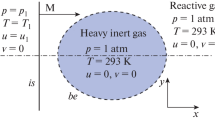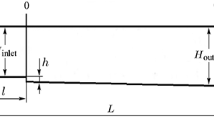Abstract
An approximate mathematical model is constructed and characteristics are calculated of ignition of a reactive plane infinite obstacle by a high-temperature nonstationary axisymmetric supersonic jet of combustion products escaping from the igniter. The approximate model data are compared with the results of numerical calculations using the system of equations of motion of an ideal gas, nonstationary equations of heat conduction and chemical kinetics, and conditions of conjugate heat exchange at the “gas–condensed medium” interface. The suggested approximate model adequately describes the ignition process and can be used for proximate evaluation of ignition time and temperature. Key words: ignition, jet, gas dynamics, supersonic flow, mathematical simulation.
Similar content being viewed by others
REFERENCES
V. N. Vilyunov, Theory of Ignition of Condensed Matters [in Russian], Nauka, Novosibirsk (1984).
V. N. Vilyunov, V. E. Zarko, Ignition of Solids, Elsevier, Amsterdam (1989).
A. G. Knyazeva and V. E. Zarko, “Numerical modeling of transients in the ignition of two-component propellants by intense heat fluxes," Combust. Expl. Shock Waves, 29, No. 3, 266–269 (1993).
L. Galfetti, G. Colombo, A. Menalli, G. Benzoni, et al., “Experimental study of solid-propellant ignition transient and flame spreading under convective flows," Combust. Expl. Shock Waves, 36, No. 1, 108–118 (2000).
A. K. Kulkarni, M. Kumar, and K. K. Kuo, “Review of solid propellant ignition studies," AIAA Paper No. 80–1210 (1980).
B. N. Yudaev, M. S. Mikhailov, and V. K. Savin, Heat Exchange in Jet-Obstacle Interaction [in Russian], Mashinostroenie, Moscow (1977).
I. A. Belov and V. S. Terpigor'ev, “Taking into account turbulence in heat-transfer calculations," Inzh.-Fiz. Zh., 17, No 4, 633–638 (1969).
G. N. Abramovitch, Applied Gas Dynamics [in Russian] Nauka, Moscow (1969).
V. S. Avduevskii, A. V. Ivanov, I. M. Karpman, et al., “Flow in a supersonic viscous underexpanded jet," Izv. Akad. Nauk SSSR, Mekh. Zhidk. Gaza, No. 3, 63–70 (1970).
I. P. Ginzburg, E. I. Sokolov, and V. N. Uskov, “Types of wave structure in the interaction of a convergent jet with an infinite two-dimensional obstruction," J. Appl. Mech. Tech. Phys., 1, No. 1, 35–39 (1976).
I. P. Ginzburg, Aerogasdynamics [in Russian], Vysshaya Shkola, Moscow (1966).
S. K. Godunov, A. V. Zabrodin, M. Ya. Ivanov, A. N. Kraiko, and G. N. Prokopov, Numerical Solution of Multidimensional Problems in Gas Dynamics [in Russian] Nauka, Moscow (1976).
M. F. Mel'nikova and Yu. N. Nesterov, “Action of a supersonic underexpanded jet on a plane obstacle perpendicular to the jet axis," Uch. Zap. TsAGI, 2, No. 5, 105–113 (1971).
Ph. Gill, W. Murray, and M. Wright, Practical Optimization, Academic Press, London (1982).
Author information
Authors and Affiliations
Rights and permissions
About this article
Cite this article
Ushakov, V.M., Starchenko, A.V. & Matvienko, O.V. Mathematical Model of Ignition of Condensed Systems by a High-Temperature Supersonic Underexpanded Jet. Combustion, Explosion, and Shock Waves 38, 409–416 (2002). https://doi.org/10.1023/A:1016250930093
Issue Date:
DOI: https://doi.org/10.1023/A:1016250930093




